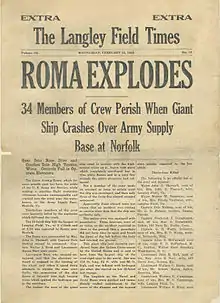Roma (airship)
Roma was an Italian semi-rigid airship, originally designated the T-34. It was purchased by the United States from the Italian government for $250,000 in 1921. It served in the US Army until February 21, 1922, when it crashed in Norfolk, Virginia, killing 34 people. It was the last hydrogen filled airship flown by the US military; all subsequent ships were inflated with helium.
| Roma | |
|---|---|
 | |
| Role | Training airship |
| National origin | Italy |
| Manufacturer | Stabilimento Construzioni Aeronautiche (SCA) |
| Designer | Umberto Nobile |
| First flight | September 1920 |
| Status | Destroyed in crash 21 February 1922 |
| Primary user | United States Army |
| Number built | 1 |
Design and development
The Roma was designed by Celestino Usuelli, the engineers Eugenio Prassone, Umberto Nobile and Colonel Gaetano Arturo Crocco.[1] It was the first project of the Stabilimento Costruzioni Aeronautiche ("Aeronautical Construction Factory"), as the partnership of Nobile, Usuelli, Croce and Giuseppe Valle and was known. The T-34 was designed for trans-Atlantic crossings. It was the largest semi-rigid airship in the world.
As a semi-rigid design it was built about a rigid keel - though the keel was partially articulated to allow some flexibility. The passenger spaces and control cabin were within the keel. The engines, 400 hp Ansaldos, were mounted outside, angled such that the slipstreams would not interfere with each other.
Service
In September 1920, Roma made its first trial flight.[2]
The airship was purchased by the United States Army for $250,000 (over $3.3 million in 2020 dollars). In March 1921, the Roma flew the 300 miles from Rome to Naples and back carrying the US Ambassador.[3]
The Roma was dismantled, packed in crates and transported by ship to the United States. After being reassembled, Roma flew again on 15 November 1921 with minor problems.[4]
Crash

The Roma crashed in Norfolk, Virginia during test flights on February 21, 1922. The crash was caused by failure of the airship's box rudder system, which allowed it to maneuver over tight areas. Just before striking the ground, the airship contacted high voltage power lines, and burst into flames. A total of 34 were killed, 8 were injured, and 3 escaped unharmed. Among the dead was the airship's pilot, Captain Dale Mabry. The event marked the greatest disaster in American aeronautics history at the time.

Master Sergeant Harry A. Chapman earned the Cheney Award for his heroics during the crash. He was the first recipient of the award and it was presented by President Coolidge in 1928.
Specifications
Data from [5]
General characteristics
- Length: 125 m (410 ft 0 in)
- Diameter: 25 m (82 ft 0 in)
- Volume: 33,810 m3 (1,193,000 cu ft)
- Empty weight: 34,500 kg (76,000 lb)
- Useful lift: 19,100 kg (42,000 lb)
- Powerplant: 6 × Liberty L12 , 300 kW (400 hp) each
Performance
- Maximum speed: 128 km/h (80 mph, 70 kn)
References
- Notes
- Flight (1920)
- Flight 23 September 1920 p.1021
- Flight 24 March 1921 p.202
- Flight 29 December 1921 p.862
- "Roma was Largest Semi-rigid Airship" (PDF). New York Times. 22 February 1922. Retrieved 2008-06-19.
- Bibliography
- "The "Roma" Disaster" (pdf), Flight, XIV (688): 140, 2 March 1922, retrieved 20 August 2011
- "The New Italian Usuelli Semi-rigid airship" (pdf), Flight, XII (614): 1044–1045, 30 September 1920, retrieved 20 August 2011
- Tampa Times, February 22, 1922. Page 1.
- New York Times, February 22, 1922. Page 1.
- Smith, Alfred Emanuel (December 7, 1921). "Photo: Trial Flight Of The Dirigible "Roma" At Langley Field, Virginia". The Outlook. 129: 554. Retrieved 2009-07-30.
- Smith, Alfred Emanuel; Walton, Francis (March 3, 1922). "The Destruction Of The Roma". The Outlook. 130: 369–370. Retrieved 2009-07-30.
| Wikimedia Commons has media related to Roma (airship). |
- Nancy E. Sheppard (25 January 2016). The Airship ROMA Disaster in Hampton Roads. Arcadia Publishing Incorporated. ISBN 978-1-62585-669-2. OCLC 944247591.
